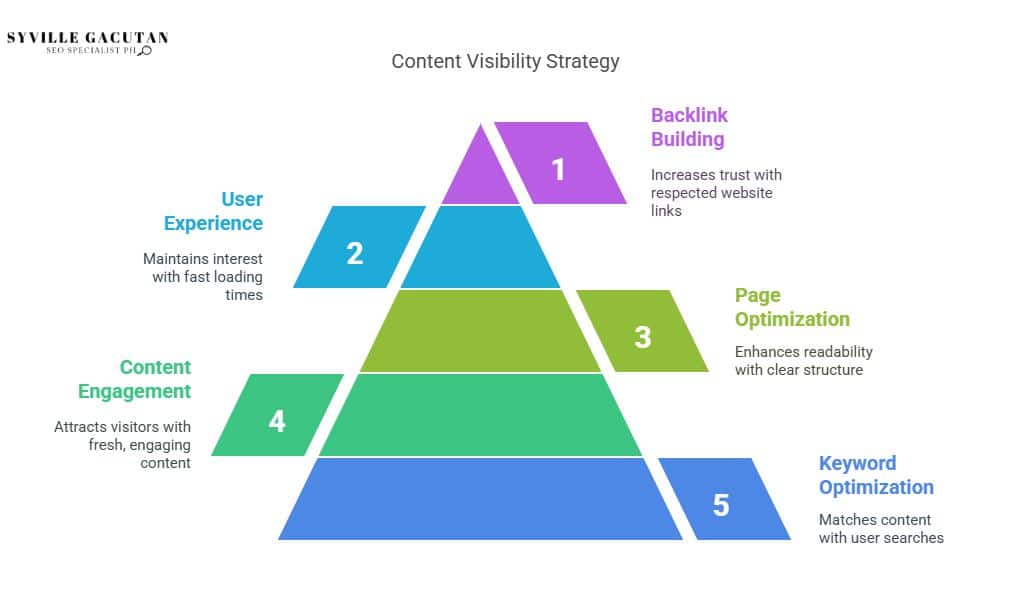
What Drives Content Visibility in Search Engines?
Content visibility in search engines is influenced by several key factors. Keyword relevance ensures content aligns with user search intent, improving potential ranking. Quality content that is fresh and engaging can attract and retain audiences. On-page optimization, including meta tags and internal linking, structures content for better search engine interpretation. User experience factors such as loading speed and mobile responsiveness enhance user satisfaction and search visibility. Backlinks from authoritative sources boost credibility, while social signals reflect content engagement. Technical SEO, such as site speed and mobile optimization, ensures the website performs optimally. Unlocking more insights in using SEO to enhance content visibility.
Key Takeaways
- Using the right keywords helps match your content with what people are really searching for, improving your rankings and making your content easier to find.
- Fresh, engaging content attracts visitors and shows that your website is relevant and trustworthy.
- Optimizing your pages with clear structure and effective meta tags makes your content more readable for both users and search engines.
- A smooth, visually appealing user experience, along with fast loading times, keeps people interested and boosts your site’s priority in search engine rankings.
- Getting backlinks from respected websites builds your site’s trustworthiness and helps boost its visibility in search results.

Keyword Relevance

Relevant keywords are essential for increasing the visibility of material in the field of search engine optimization. The rating of a website on search engine results pages (SERPs) can be greatly impacted by knowing how to use keywords efficiently.
Using long tail keywords—longer, more focused phrases that capture niche search intent—is one fundamental idea. In line with semantic search’s developing ability to understand user queries more contextually, these keywords frequently encounter less competition and can draw highly tailored traffic.
Keyword density, which refers to the frequency of a keyword’s appearance relative to the total word count, remains a critical factor. However, overemphasis can lead to keyword stuffing, which search engines may penalize. Striking a balance is essential to ensure that content remains natural while still emphasizing targeted keywords.
Search intent—understanding the purpose behind a user’s query—should inform keyword strategy, ensuring that the selected keywords match the user’s expectations and the content provides meaningful answers. This alignment fosters higher engagement and satisfaction, ultimately improving rankings.
Phrase cannibalization, which happens when several pages on a website target the same phrase and create internal competition, is a possible hazard in keyword strategy. This may confuse search engines and reduce ranking potential.
To mitigate this, a coherent keyword strategy should be in place, ensuring each page targets distinct and relevant keywords.
Quality Content

Crafting quality content is paramount for enhancing search engine visibility and user engagement. In the digital landscape, the success of content largely hinges on its ability to captivate and retain audiences. A robust approach to quality content involves not only addressing the immediate needs of the audience but also ensuring content freshness. Regular updates and timely information can significantly boost search ranking, as search engines prioritize content that remains relevant and accurate.
Audience engagement is another critical aspect of quality content. Effective content captivates its audience, encouraging interaction and prolonged dwell time. This can be achieved through multimedia integration, which enriches the user experience. Incorporating videos, images, and infographics can make information more digestible and engaging, thereby increasing the likelihood of content sharing and repeat visits.
Moreover, storytelling techniques play a vital role in forming a connection with the audience. Narratives that resonate with readers can humanize a brand, making it more relatable and memorable. A well-crafted story not only conveys information but also evokes emotion, compelling readers to take action or further engage with the brand.
Brand consistency is essential in maintaining the trust and loyalty of an audience. Consistent messaging and tone across all content pieces reinforce brand identity and ensure that users have a cohesive experience. Additionally, this consistency helps build reputation, which is important for search engine algorithms.
On-Page Optimization
Enhancing search engine visibility through on-page optimization involves a meticulous focus on various elements within a webpage that influence search rankings. This process requires a strategic approach to ensure that every aspect of the webpage is optimized to meet search engine algorithms effectively.
A critical component is the content structure, which should be organized logically with headings and subheadings to improve readability and ensure that search engines can easily interpret the page’s main themes.
Meta tags, including titles and descriptions, play a pivotal role in providing search engines with concise information about a webpage’s content. These tags should incorporate relevant keywords and be crafted to attract clicks from searchers.
Additionally, image optimization is crucial for improving page load speeds and enhancing user engagement. This can be achieved by using descriptive file names and alt text, which also serve to boost accessibility.
Furthermore, internal linking is a powerful tool that enhances the overall user experience by guiding visitors to related content, thereby increasing the time spent on the site and improving the site’s authority.
Ensuring mobile responsiveness is another essential factor, since a sizable amount of website traffic currently originates from mobile devices. Websites need to be adaptable to different screen sizes to maintain consistent functionality and appearance across all devices.
Consider these key points for effective on-page optimization:
- Content Structure: Organize information with clear headings and subheadings.
- Meta Tags: Use accurate, keyword-rich titles and descriptions.
- Image Optimization: Ensure images are optimized for speed and accessibility.
User Experience (UX)

While on-page optimization addresses the structural components of a webpage to improve search engine rankings, the overall user experience (UX) is equally significant in determining a site’s success. UX encompasses various factors that collectively enhance the user’s interaction with the website, thereby influencing its visibility in search engines. A well-executed visual design not only captivates users but also guides them intuitively through the site, reducing bounce rates and encouraging prolonged engagement—key metrics that search engines consider.
Mobile responsiveness is another critical aspect of UX, especially as mobile internet usage continues to surpass desktop traffic. Websites that seamlessly adapt their layout and functionality to different screen sizes ensure a consistent and satisfactory user experience, which search engines reward with higher rankings.
Moreover, loading speed plays a pivotal role; slow websites frustrate users, leading to higher abandonment rates. Search engines prioritize fast-loading pages to ensure users receive quick access to information.
Accessibility features are essential in making content available to a wider audience, including those with disabilities. Implementing features such as keyboard navigation, text-to-speech capabilities, and captioned multimedia not only broadens the site’s reach but also aligns with search engines’ emphasis on inclusivity.
Interactive elements, like quizzes, polls, and comment sections, further enrich the user experience by fostering engagement and community building. These elements not only enhance the user’s journey through the site but also promote longer dwell times, signaling to search engines that the content is valuable and relevant.
Thus, a focus on UX is indispensable for achieving optimal content visibility in search engines.
Backlinks and Authority

Building a robust network of backlinks plays a crucial role in establishing a website’s authority and enhancing its visibility in search engine results. The process involves strategic link building strategies that aim to acquire links from reputable and relevant websites.
These backlinks signal to search engines that your content is credible and valuable, thereby boosting your domain authority. Higher domain authority can lead to improved search rankings, making it essential for businesses to incorporate effective backlink strategies.
Understanding the value of backlinks requires an appreciation of several key factors. Firstly, niche relevance is paramount; backlinks from websites within the same industry or subject area are more valuable as they indicate contextual alignment.
Secondly, referral traffic, derived from users clicking on links from other sites, enhances not only visibility but also potential customer engagement. Finally, conducting thorough competitor analysis enables businesses to identify high-performing backlinks used by competitors and explore opportunities for similar or superior link placements.
- Niche Relevance: Acquire backlinks from sites within your industry to ensure greater search engine recognition.
- Referral Traffic: Enhance site visibility and user engagement by leveraging traffic from credible external sources.
- Competitor Analysis: Investigate competitor links to discover potential opportunities for your own link building efforts.
Incorporating these elements into a comprehensive backlink strategy can significantly impact a website’s search engine performance.
Social Signals

In the realm of SEO, social signals have emerged as an influential factor in enhancing a website’s search engine visibility. Social signals refer to the collective engagement metrics a piece of content receives across social media platforms. These metrics include likes, shares, comments, and overall interactions that demonstrate an audience’s engagement with the content.
While search engines do not directly factor social signals into their algorithms, the indirect benefits cannot be overstated.
One of the primary advantages of strong social signals is the enhancement of brand awareness. As content is shared and discussed on social media, it reaches a broader audience, increasing the likelihood of attracting new visitors to the website. This audience engagement is crucial, as it can lead to higher traffic volumes and longer dwell times, both of which are positive indicators to search engines.
Shareability factors are also essential to consider when crafting content with the potential for virality. Content that is easily shareable and resonates with its audience is more likely to gain traction on social media. This content virality can lead to significant boosts in visibility, exposing the brand to new demographics and potentially generating backlinks from other websites.
Moreover, social media platforms serve as valuable tools for testing and refining content strategies. By analyzing which types of content receive the most engagement, brands can tailor their efforts to better align with audience preferences.
In turn, this strategic alignment can enhance the overall effectiveness of their SEO campaigns, making social signals an indispensable component of modern digital marketing strategies.
Technical SEO
Technical SEO forms a crucial foundation for enhancing a website’s search engine performance and overall user experience. It encompasses a variety of elements that ensure search engines can effectively crawl, interpret, and index a site. A well-optimized technical SEO strategy can significantly improve site visibility and ranking while ensuring a seamless user experience.
One of the essential components of technical SEO is site speed. Faster-loading pages not only improve user satisfaction but also positively influence search rankings. Google considers page speed as a ranking factor, underlining its importance in technical SEO. Ensuring that your website is optimized for speed can involve compressing images, leveraging browser caching, and minimizing JavaScript.
Mobile optimization is another critical aspect. With the majority of users accessing websites via mobile devices, ensuring that your site is mobile-friendly is paramount. A responsive design that adapts to different screen sizes contributes to higher engagement and better rankings.
To further enhance search visibility, implementing structured data is key. Structured data helps search engines understand the context of content, facilitating rich snippets in search results. These snippets can increase click-through rates and improve visibility.
Addressing crawlability issues is vital to ensure search engines can access all your website’s pages. This involves optimizing robots.txt files, creating effective XML sitemaps, and fixing broken links.
Finally, HTTPS security is a crucial technical SEO factor. Transitioning to a secure HTTPS protocol not only protects user data but also boosts trustworthiness and search engine rankings.
Key takeaways for optimizing technical SEO include:
- Ensuring fast site speed for better user experience and rankings
- Implementing a responsive design for mobile optimization
- Leveraging structured data to enhance search visibility
Final Thoughts
To effectively enhance content visibility in search engines, it’s essential to adopt a comprehensive strategy that integrates keyword research, quality content creation, and on-page optimization. Understanding and utilizing relevant keywords, particularly long-tail variations, aligns your content with user intent, thereby improving its discoverability. Equally important is crafting high-quality, engaging content that resonates with your audience while maintaining freshness. On-page elements, such as optimized meta tags and a seamless user experience, further boost search rankings. Off-page strategies, like link building and social sharing, contribute to authority and reach. Continuous analysis and adaptation of your tactics, informed by performance metrics, ensure that your content remains relevant and effective in an ever-evolving digital landscape.
Ready to take your content visibility to the next level? Connect with Syville Gacutan, an experienced SEO Specialist in the Philippines. Syville can help you implement these powerful SEO strategies to drive sustainable growth and boost your online presence. Reach out today and start optimizing for success.